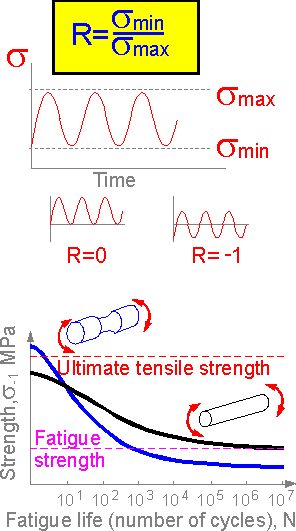 Fatigue strength is the strength of material under cyclic loading. It has unit of stress, [MPa]. Fatigue strength is usually two or more times less than ultimate tensile strength. Fatigue is characterized by fatigue strength sR, [MPa] and fatigue life N, [cycles]. R is cycle parameter, equal to the ratio of minimum and maximum stress.
Fatigue strength is the strength of material under cyclic loading. It has unit of stress, [MPa]. Fatigue strength is usually two or more times less than ultimate tensile strength. Fatigue is characterized by fatigue strength sR, [MPa] and fatigue life N, [cycles]. R is cycle parameter, equal to the ratio of minimum and maximum stress.
During the initial cycles a notched ductile steel specimen can sustain stress exceeding the ultimate tensile stress. Fatigue strength at N=105 of notched specimen is usually lower than the unnotched.
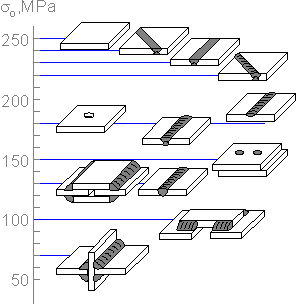 The figure shows approximate values of fatigue strength for carbon steel welded joints. The fatigue strength varies over a wide range.
The figure shows approximate values of fatigue strength for carbon steel welded joints. The fatigue strength varies over a wide range.
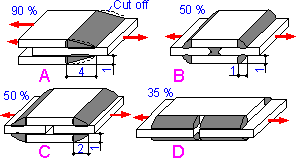 Geometry of weld affects the fatigue strength. A machined weld demonstrates greater fatigue strength. The numbers shows percentage of fatigue strength of a uniform plate under tension.
Geometry of weld affects the fatigue strength. A machined weld demonstrates greater fatigue strength. The numbers shows percentage of fatigue strength of a uniform plate under tension.
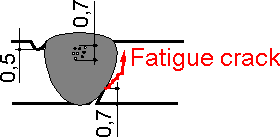 Fatigue cracks can start from all defects, but only one crack becomes dominate and results in failure. Lack of fusion on the surface is a case where the fatigue crack grows fastest.
Fatigue cracks can start from all defects, but only one crack becomes dominate and results in failure. Lack of fusion on the surface is a case where the fatigue crack grows fastest.
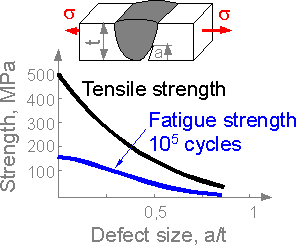 Initial manufacturing defects in welds decrease fatigue strength. The critical stress is sufficiently smaller than the static one.
Initial manufacturing defects in welds decrease fatigue strength. The critical stress is sufficiently smaller than the static one.
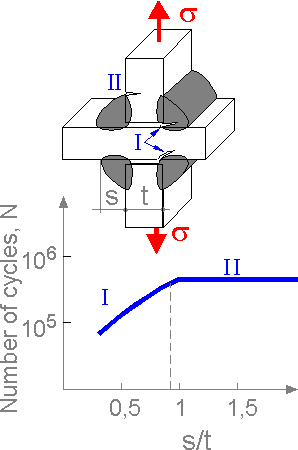 There are two main mechanisms of fatigue crack growth: I for small weld sizes s and II for large s. For large values of s the parameter does not affect the fatigue life of the joint.
There are two main mechanisms of fatigue crack growth: I for small weld sizes s and II for large s. For large values of s the parameter does not affect the fatigue life of the joint.
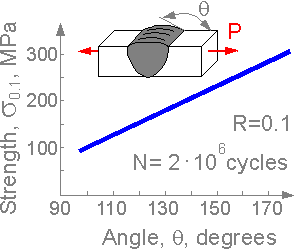 A large angle q corresponds to high fatigue strength. The effect of stress increase is higher for fatigue strength than for tensile strength.
A large angle q corresponds to high fatigue strength. The effect of stress increase is higher for fatigue strength than for tensile strength.
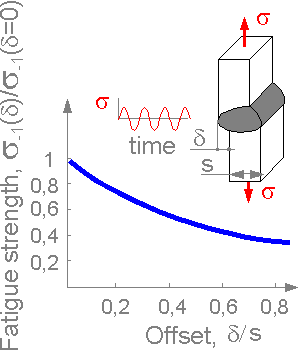 Imperfections such as offset d decreases fatigue strength of butt-welds. It creates high stress concentration, fatigue crack is initiated faster for a weld with an offset.
Imperfections such as offset d decreases fatigue strength of butt-welds. It creates high stress concentration, fatigue crack is initiated faster for a weld with an offset.
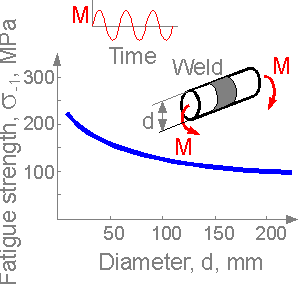 Fatigue strength decreases for greater cross-section due to larger number of surface defects and lower ability to deform plastically.
Fatigue strength decreases for greater cross-section due to larger number of surface defects and lower ability to deform plastically.
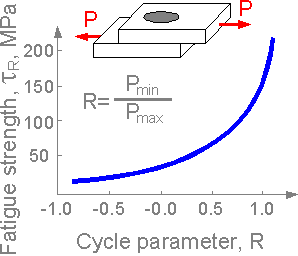 Loading with negative cycle parameter R leads to increased local plastic deformation and faster crack initiation. Fatigue strength is lower at negative cycle parameter R.
Loading with negative cycle parameter R leads to increased local plastic deformation and faster crack initiation. Fatigue strength is lower at negative cycle parameter R.
 2015-08-13
2015-08-13 370
370








